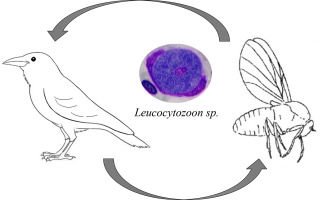Contribution to the knowledge on black flies (Diptera: Simuliidae) as vectors of Leucocytozoon (Haemosporida) parasites in Lithuania

Black flies (Diptera: Simuliidae) are among the most bothersome blood-sucking dipterans causing severe irritation and distress to poultry, wild birds, animals, and humans globally. These insects are vectors of viruses, bacteria, parasitic protozoa and nematodes of humans and animals. Parasitic protozoa belonging to Haemosporida (Apicomplexa) are distributed worldwide and black flies are the principal vectors of avian haemosporidian parasites of the genus Leucocytozoon, a common parasite of birds Based on the detection of parasite DNA in insects, 13 black fly species were reported to be potential vectors of Leucocytozoon in Europe. Information about which species of Simulium can play a role in the transmission of Leucocytozoon parasites is insufficient and needs to be developed. The aim of our study was to determine which black fly species are involved in the transmission of Leucocytozoon parasites in the Eastern Europe. The black fly females were collected in Lithuania using entomological net. They were morphologically identified, dissected to prepare salivary glands preparations, and then screened for the presence of Leucocytozoon parasites using microscopy and PCR-based methods. In all, we collected 437 black fly females belonging to eight species. The DNA of Leucocytozoon (genetic lineage lCOCO18) was detected in one of analysed females identified as Simulium maculatum. All salivary gland preparations were negative for the presence of Leucocytozoon sporozoites. Our results included S. maculatum as a potential vector of Leucocytozoon parasites. Increasing the knowledge on vector ecology, behaviour and improving collection methods may be the key to understand the evolution and diversity of these parasites.
Publisher URL: https://www.sciencedirect.com/science/article/pii/S1383576921002336
DOI: 10.1016/j.parint.2021.102515
Keeping up-to-date with research can feel impossible, with papers being published faster than you'll ever be able to read them. That's where Researcher comes in: we're simplifying discovery and making important discussions happen. With over 19,000 sources, including peer-reviewed journals, preprints, blogs, universities, podcasts and Live events across 10 research areas, you'll never miss what's important to you. It's like social media, but better. Oh, and we should mention - it's free.
Researcher displays publicly available abstracts and doesn’t host any full article content. If the content is open access, we will direct clicks from the abstracts to the publisher website and display the PDF copy on our platform. Clicks to view the full text will be directed to the publisher website, where only users with subscriptions or access through their institution are able to view the full article.


